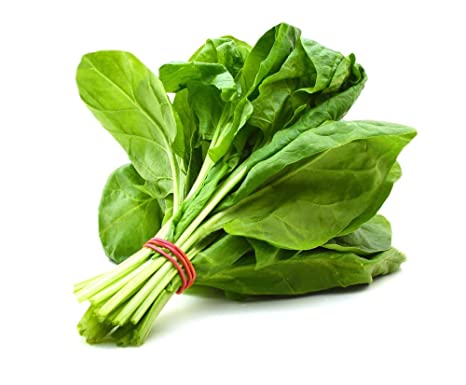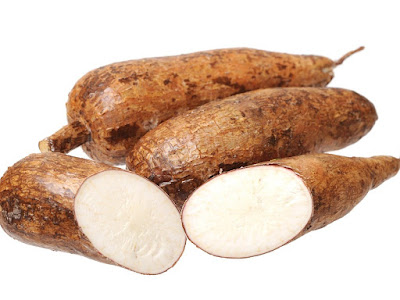Spotters in "Nutrition and Health: 'Vegetables" for CFM & MPH students
1. Green Leaves:
(a) Spinach (पालक):
Nutritional
Values (per 100 gm) & important features of spinach:
- Carbohydrate: 3.8 gm
- Protein: 0.9 gm
- Fat: 0.1 gm
- Energy: 20-26 kcal
- Minerals: 1.8 gm (
Ca- 90 mg, P-20 mg, Iron-1.6 mg)
- Crude fiber: 0.6 gm
- Moisture: 93.4 gm
- Folate: 194 µg
- Vitamin A: 9377 IU
- Vitamin C: 28.1 mg
- Vitamin K: 482 µg
- Clinical importance: Rich source of several vital antioxidant vitamins like vitamin-A, vitamin-C, and flavonoid polyphenolic antioxidants such as lutein, zeaxanthin, and β-carotene.
(b) Green amaranth (हरी चौलाई):
(c) Red amaranth (लाल चौलाई):
Nutritional
Values (per 100 gm) & important features of Amaranth:
- Carbohydrate: 4.02 gm
- Protein: 2.46 gm
- Fat: 0.33 gm
- Energy: 23 kcal
- Minerals: 3.3 gm (
Ca-215 mg, P-50 mg, Iron-2.32 mg)
- Crude fiber: 2.2 gm
- Niacin: 0.658 mg
- Riboflavin: 0.15 mg
- Vitamin A: 2917 IU
- Vitamin C: 43 mg
- Vitamin K: 1140 µg
- Moisture: 80-90 gm
- Potassium: 611 mg
- Clinical importance: Rich source of antioxidants, dietary fibers, Vitamin K. Helps to prevent osteoporosis & iron deficiency anemia.
(d) Cabbage (पत्ता गोभी):
Nutritional
Values (per 100 gm) & important features of Cabbage:
- Carbohydrate: 5.8 gm
- Protein: 1.3 gm
- Fat: 0.1 gm
- Energy: 25 kcal
- Minerals: 0.6 gm
- (Ca- 40 mg, P- 26 mg, Iron-0.47 mg, K- 170 mg, Mg:12 mg, Mn:0.16 mg )
- Crude fiber: 1 gm
- Pantothenic acid: 0.21 mg
- Pyridoxine: 0.12 mg
- Vitamin C: 36.6 mg
- Carotene: 42 µg
- Vitamin K: 76 µg
- Moisture: 91 gm
- Clinical importance: Rich source of antioxidants & minerals
(e) Fenugreek (मेथी):
Nutritional Values (per 100 gm) & important features of Fenugreek:
- Carbohydrate: 6 gm
- Protein: 4.4 gm
- Fat: 0.9 gm
- Energy: 49 kcal
- Minerals: 1.5 gm
- (Ca- 395 mg, P- 51 mg, Iron- 1.93 mg, K- 770 mg)
- Crude fiber: 1.1 gm
- Moisture: 86 gm
- Clinical importance: Rich source of Calcium, Iron & Potassium.
Special features of Green Leaves:
- Darker the green leaves, Greater their nutritive value
- Rich sources of Carotenes, Ca, Iron & Vitamin C
- Good sources of Riboflavin, Folic acid & micronutrients
- Leaf proteins: 2-4%
- Good source of lysine
- Deficient in sulphur containing amino acids
- High water content & dietary fibers
- Energy: 25-50 kcal per 100 gm
- Recommended daily intake: 40 gm for an adult
- Bio availability of Ca & Iron poor due to presence of Oxalates in high amount
- Clinical Importance: Contains good amount of dietary fibers useful for prevention of colon cancer, constipation & obesity.
2. Roots & Tubers:
(a) Potato (आलू):
Nutritional
Values (per 100 gm) & important features of Potato:
- Carbohydrate: 17.49 gm
- Protein: 2.05 gm
- Fat: 0.1 gm
- Energy: 77 kcal
- Minerals:(
Ca-12 mg, P- 57 mg, Iron-0.81 mg, K-425 mg)
- Dietary fiber: 2.1 gm
- Niacin: 1.06 mg
- Pyridoxine: 0.298 mg
- Pantothenic acid: 0.279 mg
- Vitamin C: 19.7 mg
- Moisture: 74.7 gm
- Clinical importance: Rich source of B-complex group of vitamins, anti-oxidants & minerals
(b) Sweet potato (शकरकंद):
Nutritional
Values (per 100 gm) & important features of sweet potato:
- Carbohydrate: 28.2 gm
- Protein: 1.2 gm
- Fat: 0.0 gm
- Energy: 120 kcal
- Minerals: 1 gm (
Ca- 46 mg, P-50 mg, Iron-0.2 mg)
- Crude fiber: 0.8 gm
- Thiamine: 0.06 mg
- Riboflavin: 0.04 mg
- Niacin: 0.7 mg
- Vitamin C: 24 mg
- Carotene: 6 µg
- Moisture: 68.5 gm
- Clinical importance: Rich in vitamin C, fibers & potassium.
(c) Tapioca (कसावा):
Nutritional
Values (per 100 gm) & important features of Tapioca:
- Carbohydrate: 38 gm
- Protein: 1.36 gm
- Fat: 0.28 gm
- Energy: 160 kcal
- Minerals: (
Ca-16 mg, Mg-21 mg, Iron- 0.21 mg, K-271 mg)
- Dietary fiber: 1.8 gm
- Niacin: 0.85 mg
- Vitamin C: 20.6 mg
- Moisture: 59.4 gm
- Gluten free
- Clinical importance: Unsuitable for diabetics. Ingesting poorly processed tapioca roots may cause cyanide poisoning.
(d) Yam/Jicama (शंख-आलू/ मिश्रीकंद):
Nutritional
Values (per 100 gm) & important features of Yam:
- Carbohydrate: 8.8 gm
- Protein: 0.72 gm
- Fat: 0.19 gm
- Energy: 38 kcal
- Minerals: ( Mg-12 mg, Iron- 0.6 mg, K-150 mg)
- Dietary fiber: 4.9 gm
- Vitamin C: 20.2 mg
- Moisture: 70 gm
- Clinical importance: excellent source of oligofructose inulin a soluble dietary fiber. Good for diabetics. Rich in vitamin C.
(e) Carrots (गाजर):
Nutritional
Values (per 100 gm) & important features of Carrots:
- Carbohydrate: 10.6 gm
- Protein: 0.9 gm
- Fat: 0.2 gm
- Energy: 48 kcal
- Minerals: 1.1 gm (
Ca- 80 mg, P-530 mg, Iron- 1 mg)
- Crude fiber: 1.2 gm
- Niacin: 0.6 mg
- Thiamine: 0.04 mg
- Riboflavin: 0.02 mg
- Folic acid: 15 mg
- Vitamin C: 3 mg
- Carotene: 1890 µg
- Moisture: 86 gm
- Clinical importance: Very high in beta-carotene & vitamin A. Rich in anti-oxidants & vitamin C.
(f) Onion (प्याज):
Nutritional
Values (per 100 gm) & important features of onion:
- Carbohydrate: 12.6 gm
- Protein: 1.8 gm
- Fat: 0.1 gm
- Energy: 59 kcal
- Minerals: 0.6 gm (
Ca- 40 mg, P-60 mg, Iron-0.46 mg)
- Crude fiber: 0.6 gm
- Thiamine: 0.08 mg
- Riboflavin:0.02 mg
- Niacin: 0.5 mg
- Vitamin C: 2 mg
- Carotene: 15 µg
- Moisture: 84.3 gm
- Clinical importance: Contains allium and Allyl disulfide which convert into allicin by the enzymatic reaction when its bulb are distorted(cutting, crushing) & it has anti-mutagenic and anti-diabetic properties.
(g) Radish (मूली):
Nutritional
Values (per 100 gm) & important features of Radish:
- Carbohydrate: 3.4 gm
- Protein: 0.68 gm
- Fat: 0.1 gm
- Energy: 16 kcal
- Minerals: (
Ca-25 mg, K-233 mg, Cu-0.05 mg)
- Dietary fiber: 1.6 gm
- Pyridoxine: 0.07 mg
- Niacin: 0.25 mg
- Vitamin C: 14.8 mg
- Folates: 25 µg
- Clinical importance: Rich in antioxidants & vitamin C.
(h) Colocasia (अरवी):
Nutritional
Values (per 100 gm) & important features of Colocasia:
- Carbohydrate: gm
- Protein: 3 gm
- Fat: 0.1 gm
- Energy: 97 kcal
- Minerals: 1.7 gm
- (Ca- 40 mg, P-140mg, Iron-0.4 mg, K-591mg, Cu-0.17mg)
- Crude fiber: 1 gm
- Thiamine: 0.09 mg
- Riboflavin: 0.03 mg
- Niacin: 0.4 mg
- Pyridoxine: 0.28 mg
- Folic acid: 54 mg
- Carotene: 24 µg
- Moisture: 73.1 gm
- Clinical importance: Rich in antioxidants, pyridoxine & copper.
(i) Beetroot (चुकंदर):
Nutritional
Values (per 100 gm) & important features of Beetroot:
- Carbohydrate: 8.8 gm
- Protein: 1.7 gm
- Fat: 0.1 gm
- Energy: 43 kcal
- Minerals: 0.8 gm
- (
Ca-18 mg, P-55 mg, Iron-1.2 mg, K-529 mg)
- Crude fiber: 0.9 gm
- Thiamine: 0.4 mg
- Riboflavin:0.9 mg
- Niacin: 0.4 mg
- Vitamin C: 10 mg
- Moisture: 87.5 gm
- Clinical importance: Rich in glycine betaine, homocysteine, folate & vitamin C.
3. Other Vegetables:
(a) Eggplant/ Brinjal (बैगन):
Nutritional
Values (per 100 gm) & important features Brinjal:
- Carbohydrate: 5.7 gm
- Protein: 1 gm
- Fat: 0.19 gm
- Energy: 24 kcal
- Minerals:(Ca- 9 mg, K-230 mg, Iron- 0.24 mg, Mn-0.25 mg)
- Dietary fiber: 3.4 gm
- Pantothenic acid: 0.28 mg
- Niacin: 0.65 mg
- Folates: 22 µg
- Clinical importance: Rich in antioxidants specially anthocyanins. Contains good amount of pantothenic acid & potassium.
(b) Tomato (टमाटर):
Nutritional
Values (per 100 gm) & important features of Tomato:
- Carbohydrate: 3.9 gm
- Protein: 0.9 gm
- Fat: 0.2 gm
- Energy: 18 kcal
- Minerals: gm (
Ca- 10 mg, K- 237 mg, Iron-0.3 mg)
- Dietary fiber: 1.2 gm
- Niacin: 0.59 mg
- Vitamin A: 833 IU
- Vitamin C: 13 mg
- Carotene: 550 µg
- Vitamin K: 7.9 µg
- Clinical importance: Contains antioxidants lycopene & zea-xanthine. Also a good source of vitamin A & C.
(c) Cauliflower (फूलगोभी):
Nutritional
Values (per 100 gm) & important features of Cauliflower:
- Carbohydrate: 4.97 gm
- Protein: 1.92 gm
- Fat: 0.28 gm
- Energy: 25 kcal
- Minerals: gm (
Ca-22 mg, K-299 mg, Iron- 0.42 mg)
- Dietary fiber: 2 gm
- Pantothenic acid: 0.67 mg
- Pyridoxine: 0.18 mg
- Vitamin C: 48.2 mg
- Vitamin K: 15.5 µg
- Folates: 57 µg
- Clinical importance: A good source of vitamin C. Contains phytochemicals sulforaphane & plant sterols indole-3-carbinol.
- National Institute of Nutrition (India), Gopalan, C., Rama, S. B. V., & Balasubramanian, S. C. (1978). Nutritive value of Indian foods. Hyderabad, India: National Institute of Nutrition, Indian Council of Medical Research.
- Park, K. (2015). Park's textbook of preventive and social medicine. 23rd. Jabalpur, India: M/S Banarsidas Bhanot.
- Longvah T, An-antan I, Bhaskarachary K, Venkaiah K. Indian food composition tables. Hyderabad: ICMR-National Institute of Nutrition; 2017.
- Mohan Ram M and I Gopalan (1981). Nutritional Disabilities, ICMR, National Institute of Nutrition, Hydrabad.
- Tricase, C., Amicarelli, V., Lamonaca, E., & Rana, R. L. (2018). Economic analysis of the barley market and related uses. In Grasses as Food and Feed. IntechOpen.
- https://fdc.nal.usda.gov/fdc-app.html#/food-details/172436/nutrients
- https://plants.usda.gov/plantguide/pdf/pg_caca27.pdf
- https://fdc.nal.usda.gov/fdc-app.html#/food-details/168462/nutrients
- https://www.amazon.in/Super-Agri-Green-Spinach-Quality/dp/B01E2BKW78 Photo credit
- https://www.specialtyproduce.com/produce/Green_Amaranth_12831.php photo credit
- https://www.specialtyproduce.com/produce/Red_Amaranth_5382.php photo credit
- https://www.thehealthsite.com/parenting/cabbage-leaves-a-natural-way-to-treat-breast-engorgement-d0216-368838/ photo credit
- https://ruttstores.com/product/vegetables/fenugreek-leaves-methi photo credit
- https://www.indiamart.com/proddetail/locker-potato-4776720248.html photo credit
- http://www.farmbox.in/product/tapioca-1-kg/ photo credit
- https://www.indiamart.com/proddetail/shankh-aloo-fruit-20565992755.html photo credit
- https://food.ndtv.com/ingredient/carrot-700973 photo credit
- https://www.amazon.com/White-Sweet-Potatoes-Locally-Pounds/dp/B07939LLKW photo credit
- https://www.amazon.in/Fresh-Onion-1kg-Pack/dp/B07BG62MBV photo credit
- https://www.indiamart.com/proddetail/white-radish-16937025673.html photo credit
- https://www.thehealthsite.com/diseases-conditions/health-benefits-of-arbi-colocasia-taro-root-bs915-329069 photo credit
- https://www.medicalnewstoday.com/articles/277432 photo credit
- https://www.amazon.in/MaliaGarden-Brinjal-Eggplant-Kitchen-Gardening/dp/B07J5NX7JY photo credit
- http://www.lima-europe.eu/processing-tomato photo credit
- https://www.indiamart.com/proddetail/fresh-cauliflower-19787774262.html photo credit
























Comments
Post a Comment